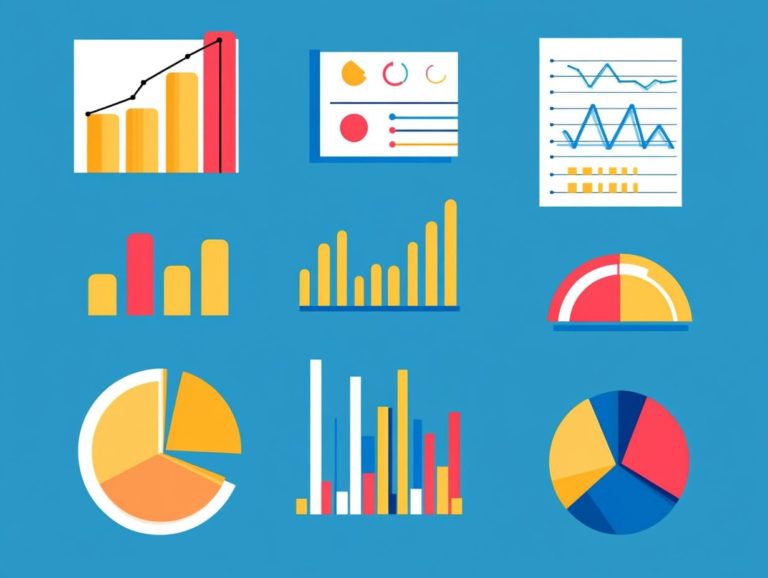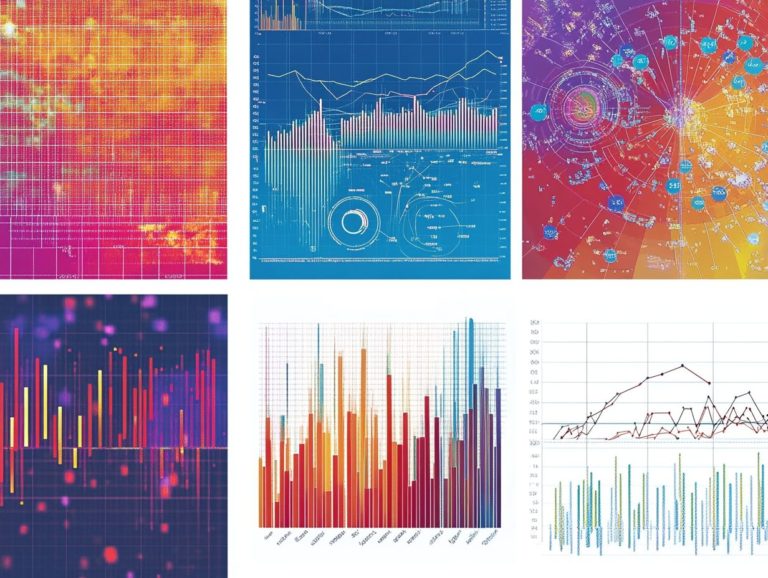5 reporting metrics every project manager should know
In the fast-paced realm of project management, you may find it challenging to keep everything on track. Understanding key performance metrics is crucial for assessing a project’s success. This helps in making informed decisions.
This article covers five key reporting metrics every project manager must know:
- Cost Variance
- Schedule Variance
- Return on Investment
- Resource Utilization
- Project Performance Index
It also highlights the significance of project reporting, effective communication with stakeholders, and the common pitfalls you should steer clear of.
Engage with this content to elevate your project management skills and enhance your project outcomes!
Contents
- Key Takeaways:
- 1. Cost Variance (CV)
- 2. Schedule Variance (SV)
- 3. Return on Investment (ROI)
- 4. Resource Utilization
- 5. Project Performance Index (PPI)
- What Is Project Reporting and Why Is It Important?
- What Are the Key Metrics to Measure Project Performance?
- How Can Project Managers Use These Metrics to Improve Project Success?
- What Tools and Techniques Can Help with Project Reporting?
- How Can Project Managers Communicate These Metrics to Stakeholders?
- What Are the Common Mistakes to Avoid in Project Reporting?
- Frequently Asked Questions
- What are the five essential reporting metrics every project manager should know?
- How Can Project Timeline Reporting Help Project Managers?
- Why Is Monitoring Budget and Cost Important?
- How Does Scope Change Reporting Benefit Managers?
- How Can Team Productivity Reporting Help?
- What Role Does Stakeholder Satisfaction Reporting Play?
Key Takeaways:

Stay on budget and on track by measuring cost and schedule variances (CV and SV). Knowing the return on investment (ROI) empowers you to prioritize resources effectively. Keep a close eye on resource utilization and project performance index (PPI) to seize opportunities for improvement and ensure fantastic project outcomes!
1. Cost Variance (CV)
Cost Variance (CV) is an essential metric in the agile framework that allows you to measure the gap between the budgeted cost of work performed and the actual expenses incurred. This offers invaluable insights into productivity for software development teams and project managers assessing a project’s financial health.
To calculate CV, you can use the straightforward formula: CV = EV (Earned Value) – AC (Actual Cost). Earned Value (EV) is the value of work actually completed, while Actual Cost (AC) is the real cost incurred for that work. This approach enables you to identify precisely where you stand in relation to your budget.
For example, if you have an earned value of $50,000 but find that actual costs have climbed to $60,000, your CV will indicate a $10,000 overage an alert that immediate corrective action is necessary.
This metric gives you the power to make informed choices regarding resource allocation and risk management. By incorporating related agile metrics, such as budget estimates and cycle time, you can further bolster your cost-control efforts.
Regularly reviewing these metrics helps you adjust your strategies. This keeps your projects on track and within budget, and utilizing the right tools, such as 5 tools for tracking project progress, can further reduce the risk of financial strain.
2. Schedule Variance (SV)
Schedule Variance (SV) stands as a pivotal agile KPI metric, highlighting the discrepancy between your project’s planned progress and its actual advancement. This measure provides invaluable insights into your team s performance and productivity throughout the software development lifecycle.
By calculating SV, you can swiftly determine whether you’re on track to meet your timelines or if it s time to make some adjustments. This metric acts as an essential feedback loop, allowing you and your team to reflect on your sprints and refine your strategies as needed.
Grasping SV gives you the power to enhance your burndown charts, which show how much work remains versus time. This enables proactive management of both scope and resources. By consistently monitoring SV, you can pinpoint bottlenecks early on and ensure that your efforts align with overarching project goals, fostering a culture of accountability and continuous improvement within your project management framework.
3. Return on Investment (ROI)
Return on Investment (ROI) is a pivotal business metric that evaluates how profitable an investment is in relation to its cost. It s an essential tool for gauging client satisfaction and assessing overall project performance, particularly in the realm of agile software development.
By calculating ROI, you can effectively compare various investments, helping you pinpoint which projects promise the greatest financial returns. This metric not only sheds light on the financial viability of a project but also aligns your expectations with the realities faced by project owners.
Consider high ROI projects, such as those employing automated testing or continuous integration. These initiatives have showcased impressive profit potential, enhancing efficiency while simultaneously cutting costs.
By incorporating agile metrics like velocity and customer satisfaction scores your teams can track their progress and refine their strategies. This ultimately boosts ROI outcomes, ensuring that both stakeholders and clients achieve their desired results.
4. Resource Utilization

Resource utilization focuses on maximizing your team members’ skills and time in software development projects. It s a crucial element of project management that influences overall productivity and helps keep uncontrolled changes to the project at bay.
By aligning tasks with the right skill sets within an agile framework, you can maximize output while minimizing wasted effort. This alignment enhances delivery timelines and engages the workforce.
When team members are assigned tasks that match their expertise, they are more likely to thrive and find satisfaction in their roles. To measure and boost these utilization rates, consider employing methodologies like workload assessments and performance metrics.
Tools such as kanban boards provide real-time visibility into team capacities. This allows you to make informed decisions that prevent resources from being overstretched, safeguarding your project from potential pitfalls and ensuring that your objectives remain clear and attainable.
5. Project Performance Index (PPI)
The Project Performance Index (PPI) evaluates the overall effectiveness of your project by taking into account multiple agile metrics. This gives you a thorough overview of project health and quality assessment throughout the software development lifecycle.
By integrating elements like backlog burn-down (tracking remaining work), sprint velocity (measuring how much work is completed in a sprint), and cycle time (the total time from start to finish of a task), the PPI delivers a holistic perspective on performance. This is invaluable for you as a project manager.
When you leverage the PPI, you can make informed, data-driven decisions that significantly enhance both project outcomes and quality. For example, analyzing trends in velocity may uncover areas where your team can boost efficiency.
Meanwhile, focusing on cycle time can help you identify bottlenecks, allowing for timely interventions. In this ever-evolving environment, understanding the PPI gives you and your team the power to stay aligned and consistently deliver high-value outcomes.
What Is Project Reporting and Why Is It Important?
Project reporting is your structured pathway to documenting and communicating the progress, challenges, and metrics of a project. It plays a vital role in ensuring transparency and accountability.
Additionally, it enhances team performance and facilitates quality assessments in software development. In the world of agile methodologies, effective project reporting becomes even more significant.
It fosters a collaborative spirit among team members and stakeholders, creating a sense of unity. By incorporating agile metrics like velocity, sprint burndown, and cumulative flow diagrams, you can track your progress and pinpoint areas that need immediate attention and improvement.
This increased visibility opens the door for open discussions and well-considered choices, essential for adapting to the ever-evolving project landscape. Don t miss the chance to improve your project outcomes!
Ultimately, embracing these reporting practices enriches individual and collective understanding while aligning everyone with the project’s goals. This cultivates a more cohesive and productive work environment.
What Are the Key Metrics to Measure Project Performance?
Key metrics for measuring your project performance include an array of agile KPI metrics that shed light on team productivity, client satisfaction, and the overall success of your initiatives. Understanding these essential time tracking metrics for project managers is vital for making informed decisions.
Among the most critical metrics you should keep an eye on are:
- Cost Variance (CV): Measures financial performance by comparing budgeted and actual costs.
- Schedule Variance (SV): Evaluates project timelines against planned progress.
Additionally, Return on Investment (ROI) measures the profitability of your project in relation to its costs. By analyzing these metrics, you can quickly adjust your approach, ensure resources are allocated efficiently, and ultimately drive your project’s success.
How Can Project Managers Use These Metrics to Improve Project Success?

You can leverage agile metrics to improve project success. Identify areas for improvement, track team performance, and make data-driven decisions that meet project goals and client expectations.
You can adopt specific strategies, such as establishing key performance indicators, or KPIs, which are measurable values that demonstrate how effectively a company is achieving its key business objectives, and conducting regular sprint reviews, to gain a clearer perspective on project progress.
Fostering open communication channels within your team allows you to uncover insights that raw numbers might overlook. It s crucial to routinely analyze these metrics, enabling you to make informed adjustments in real time.
By continually evaluating these metrics, you can supercharge project performance and ensure client satisfaction. For more insights, consider understanding project reporting, which will ultimately help solidify a positive relationship for future collaborations.
What Tools and Techniques Can Help with Project Reporting?
Tools like Jira and Teamwork.com are your best friends for effective project reporting! They empower you to track agile metrics, visualize progress, and streamline communication, all contributing to improved project outcomes.
These platforms facilitate real-time tracking of project timelines and offer customizable dashboards, making it easy for you to interpret data at a glance. With collaborative features, they enable seamless updates and interactions among team members, significantly reducing the chances of miscommunication.
Asana and Trello enhance reporting efficiency by integrating with other applications to gather all relevant information in one place. This allows you to perform comprehensive analyses and make informed decisions.
By leveraging these tools, you can boost accountability, swiftly identify bottlenecks, and maintain an agile approach to project management, ultimately leading to superior overall performance.
How Can Project Managers Communicate These Metrics to Stakeholders?
Effectively communicating project metrics to stakeholders is crucial for keeping clients informed and engaged throughout the software development journey. Utilizing the right tools, such as the 5 tools for tracking project KPIs, can enhance this process significantly.
By understanding the diverse backgrounds and expectations of various stakeholders ranging from technical teams to executive decision-makers you can tailor your presentations with precision.
Incorporating visual aids, concise summaries, and relevant data points that resonate with each audience will enhance clarity and promote active engagement. Using charts and graphs captures attention and makes complex data easy to digest.
Regular updates should go beyond just sharing numbers; they should narrate the story of progress, challenges, and future actions. This ensures that stakeholders feel genuinely included in the decision-making process.
Ultimately, this approach fosters a collaborative atmosphere that invites feedback and strengthens relationships.
What Are the Common Mistakes to Avoid in Project Reporting?
Common mistakes in project reporting can significantly undermine the effectiveness of your agile metrics, leading to misinterpretations and poor quality assessments. To avoid these pitfalls, consider utilizing tools for effective project analytics that can enhance project success and bolster stakeholder confidence.
These pitfalls often arise from unclear data presentation, inconsistent formats, or an overload of information that confuses rather than clarifies. When project teams fail to present metrics accurately and succinctly, they risk obscuring critical insights that stakeholders need to make informed decisions.
To sidestep these errors, it s essential for you to establish a standardized reporting framework that prioritizes clarity and relevance. Regularly seeking feedback from stakeholders on the reporting process can aid in identifying and rectifying common misunderstandings before they develop into larger issues.
Frequently Asked Questions

What are the five essential reporting metrics every project manager should know?
The five key reporting metrics every project manager should know are project timeline, budget and cost, scope creep, team productivity, and stakeholder satisfaction. Utilizing reporting templates every project manager needs can help track the progress and success of their projects and make informed decisions.
How Can Project Timeline Reporting Help Project Managers?
Project timeline reporting lets managers track their projects effectively. It helps them stay on schedule while spotting potential delays early.
Why Is Monitoring Budget and Cost Important?
Keeping an eye on budget and costs reveals any differences between planned and actual expenses. This way, managers can adjust quickly to avoid budget overruns.
How Does Scope Change Reporting Benefit Managers?
Scope change reporting allows managers to monitor any additions to the project. By managing these changes, they can prevent delays and extra costs.
How Can Team Productivity Reporting Help?
Team productivity reports show how efficiently team members are working. This insight helps managers identify areas for improvement and provide necessary support.
What Role Does Stakeholder Satisfaction Reporting Play?
Stakeholder satisfaction reports let managers gauge how happy clients and team members are. This valuable feedback can enhance relationships and drive improvements.






